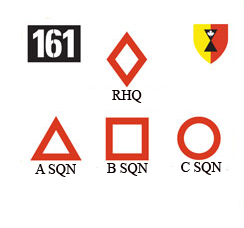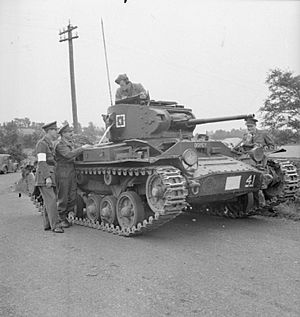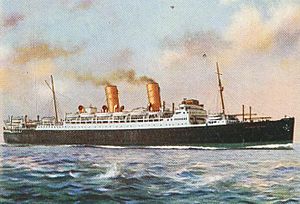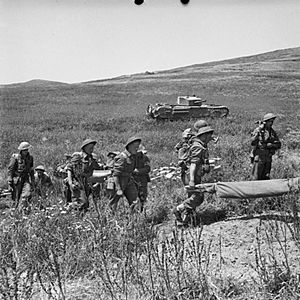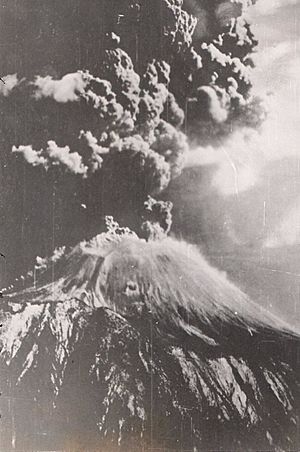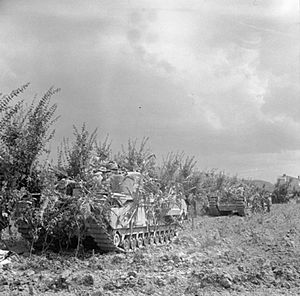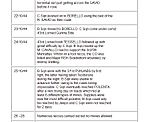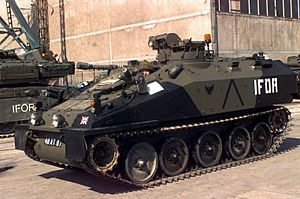North Irish Horse facts for kids
Quick facts for kids North Irish Horse |
|
|---|---|
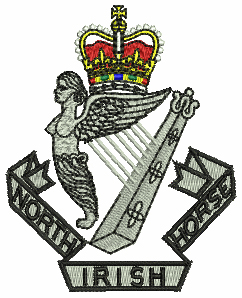
The badge of the North Irish Horse.
|
|
| Active | 1902–1946 1947–present (as a Sqdn) |
| Country | |
| Branch | |
| Type | Yeomanry |
| Role | Formation Reconnaissance and Signals |
| Size | Two Squadrons |
| Part of | Royal Armoured Corps and Royal Signals |
| Garrison/HQ | Belfast |
| Nickname(s) | The Horse, The Millionaires Own |
| Motto(s) | Quis Separabit (Who shall separate us) (Latin) |
| March | Garryowen |
| Anniversaries | Hitler Line, 24 May |
| Engagements | Somme, Ypres, Hitler Line, Iraq, Afghanistan |
| Commanders | |
| Honorary Colonel | Colonel J W Rollins MBE |
| Insignia | |
| Tartan | Saffron (pipes) |
The North Irish Horse was a special army unit from the British Territorial Army. It was formed in the northern parts of Ireland in 1902, after the Second Boer War. This unit was supported by important families and was one of the first non-regular groups sent to France in World War I.
The North Irish Horse fought bravely, first on horseback and later as a bicycle regiment. They earned many awards for their courage. After World War I, the unit became very small. But it was reformed for World War II and achieved its greatest successes in North Africa and Italy. Today, the name "North Irish Horse" lives on in two smaller army units.
Contents
- History of the North Irish Horse
- Unit Support
- Special Flags and Memorials
- Unique Uniforms
- Battle Honors and Awards
- Notable People from the North Irish Horse
- Images for kids
History of the North Irish Horse
How the Unit Started
In the late 1700s, special army groups called "Militia" units were created in Ireland. These groups were made up of local volunteers. In 1796, more cavalry (horse-riding) units were formed, known as "yeomanry." Each soldier had to provide their own horse. These units were eventually disbanded in 1834.
Later, during the Boer War, new cavalry squadrons were quickly formed. These new units were called the "Imperial Yeomanry." They were given rifles instead of traditional swords. Six companies were raised in Ireland, including some from Belfast and Dublin. One famous group, the 47th, was known as the "Millionaires Own" because its members were very wealthy.
Forming the North Irish Horse
After the war in South Africa, King Edward VII approved the creation of two new yeomanry regiments in Ireland in 1901. One was the North of Ireland Imperial Yeomanry. This unit started recruiting in 1903 and formed four main groups, called squadrons. These squadrons were based in Belfast, Derry/Ballymena, Enniskillen, and Dundalk.
In 1908, the unit's name changed to the North Irish Horse. This was part of bigger army changes that allowed Irish units to serve overseas. The first leader of the North Irish Horse was the Earl of Shaftesbury.
The First World War Experience
When World War I began in August 1914, the North Irish Horse was at its summer training camp. One squadron, called A Squadron, was sent to France on August 17, 1914. They were among the very first non-regular British troops to arrive and fight in the war. More squadrons joined them later. In total, over 2,000 men from the regiment went to war between 1914 and 1916.
The North Irish Horse squadrons often fought separately. They were attached to different larger army groups as needed. For example, A Squadron joined the 55th (West Lancashire) Division, and C Squadron joined the 5th Division.
Becoming Cyclist Soldiers
As the war turned into trench warfare, cavalry (horse-riding soldiers) couldn't move easily. Many cavalry regiments had to give up their horses. They were then used for other tasks, like infantry (foot soldiers) or even simple jobs like burying the dead. This meant many soldiers felt they weren't actively fighting.
After a while, some parts of the regiment became "cyclist battalions." This meant they used bicycles for movement. During the "Great Retreat of 1918," they were involved in a major German attack. After the war ended, the regiment prepared to return to Ireland.
During World War I, the North Irish Horse earned 18 battle honors (awards for bravery in specific battles). They lost 27 officers and 123 men. One officer, Captain Richard Annesley West, was awarded the Victoria Cross, the highest military award.
Between the World Wars
By 1919, the regiment was greatly reduced in size. Most of the soldiers were sent home. The regiment's horses were given to another unit. The North Irish Horse officially "disembodied," meaning it existed only as a name on the army list.
In 1921, the unit was renamed "the Militia." By 1922, after Ireland was divided, the South Irish Horse unit was disbanded. This left the North Irish Horse as the only cavalry militia regiment left.
The "One Man Regiment"
Over time, the number of active officers in the North Irish Horse kept shrinking. By 1934, only one officer, Major Sir Ronald D Ross, was left. This led to the nickname "the One Man Regiment." This continued until 1938, when the British government decided to increase army numbers because of the growing threat of war from Germany.
The Second World War Experience
Getting Ready for War
On August 31, 1939, the War Office ordered the North Irish Horse to be reformed. It became a unit with armored cars. Recruiting started, and instructors trained new soldiers. By September, the regiment joined the Royal Armoured Corps (RAC). In January 1940, they received old Rolls-Royce armored cars with machine guns.
Training continued, and in April 1941, the regiment moved to Ballykinlar. They were re-equipped with Mk I Valentine tanks. Later, they received Churchill tanks.
Naming the Tanks
It became a tradition for Irish army units to name their tanks after Irish towns. The first letter of the town's name matched the squadron's letter. For example:
- HQ Squadron: Donegal, Dundalk
- A Squadron: Antrim, Armagh
- B Squadron: Belfast, Ballymena
- C Squadron: Cork, Coleraine
In September 1942, the regiment joined the 25th Army Tank Brigade. Before Christmas, soldiers were called back from leave and told to prepare for overseas service. They traveled to Liverpool and boarded the troopship Duchess of York.
Fighting in Tunisia
On February 2, 1943, the North Irish Horse landed in Algiers, North Africa. Their first job was to defend Le Kef. Many of their tanks and equipment were delayed. The regiment quickly moved to Béja to stop a German attack. This was one of the longest journeys ever made by Churchill tanks. They fought against German tanks and artillery, taking their first casualties.
The regiment continued to support other units. They took heavy losses but kept moving forward. In April, they all came together for the first time since arriving in Algiers. The Churchill tanks showed how agile they were by climbing hills that the Germans thought tanks couldn't reach. This surprised the enemy. One famous example was the attack on Djebel Rhar (Longstop Hill). German soldiers panicked when the Churchill tanks appeared on the hill. One German prisoner called the tanks "Iron Mules."
On May 6, the final attack on Tunis began. After fierce street fighting, the town was captured. This ended the campaign in Tunisia.
The Italian Campaign Begins
After the fighting in Tunisia, the North Irish Horse rested and received new tanks and soldiers. On April 16, they sailed to Naples, Italy. As they entered the harbor, they were attacked from the air. Nearby, Vesuvius volcano was erupting.
The regiment received Sherman tanks and moved towards Monte Cassino. The fighting was not over, as the strong German Adolf Hitler Line, now called the Senger Line, was just six miles north.
Breaking the Hitler Line
The North Irish Horse was part of an attack called Operation Chesterfield. This was a major assault by Canadian soldiers supported by tanks. The attack began at 6 AM on May 23. The attacking troops faced heavy German fire. The North Irish Horse took many casualties and lost 32 tanks. One tank even fell 50 feet into a ravine but its crew was unhurt. They showed the amazing climbing skills of the Churchill tank by crawling back up the steep walls.
During this battle, Major Griffiths showed great bravery and received another award. The regiment lost 36 men killed on May 23, making it the bloodiest day in their history. However, the German defenses were broken, and the Allies continued to advance.
After breaking the Hitler Line, the Canadian soldiers asked the North Irish Horse to wear the Maple Leaf symbol, which is now on the Flag of Canada. This was a sign of thanks for their support.
Pushing Through Italy
The regiment then moved west towards Perugia, which fell on June 20. New, improved Churchill tanks arrived.
The Gothic Line Battle
Advancing through mountains, another tank rolled down a slope, killing one crew member and injuring others. The race was on to push the Germans back. On September 3, the regiment crossed the Conca river and attacked Coriana. On September 8, they learned that the Gothic Line had been broken.
On November 29, the regiment was advancing north. Their commanding officer, Lt Col Lord O'Neill, was killed by a shell.
The autumn rains arrived, slowing the Allied advance. The regiment continued fighting until November 3, when they were pulled out of the line for rest.
End of the Italian Campaign
The advance north continued. The Churchill tanks again proved useful for crossing rivers and muddy ground. The regiment eventually got a long period of rest. In January, they moved into Ravenna to support Italian soldiers who were now fighting with the Allies.
In late March, the regiment fought along the Senio river. They engaged the enemy at close range. German resistance crumbled, and the North Irish Horse took 40 prisoners.
On April 30, 1945, the regiment was ordered to stand down for the last time in World War II. Two days later, all German forces in Italy surrendered.
The North Irish Horse lost 73 men killed during World War II.
After the Wars
After the German surrender, the regiment performed guard duties. They moved to Austria and then to Germany, where they carried out security tasks. On June 7, 1946, the North Irish Horse was disbanded.
However, in 1947, it was reformed as part of the Territorial Army. In 1956, the unit became an armored reconnaissance regiment, using armored cars. It managed to avoid being disbanded several times.
In 1967, the Horse was disbanded again but then re-established as D Squadron of The Royal Yeomanry. In 1969, another part of the unit became a signal squadron, helping with communications.
In 1992, the Horse was re-established as an independent reconnaissance squadron, using Land Rovers. Later, it joined the Queen's Own Yeomanry as B Squadron and used Spartan armored vehicles.
Today, the name B (North Irish Horse) Squadron still exists in the Army Reserve. They are based in Belfast and use Scimitar and Spartan vehicles. Soldiers from this unit have served in places like Kosovo, Bosnia, Iraq, and Afghanistan.
In 2009, there was an incident at their camp in Belfast, but no one was seriously hurt.
Under new army plans, B (North Irish Horse) Squadron now belongs to the Scottish and North Irish Yeomanry. The signal squadron is now 40 (North Irish Horse) Signal Squadron.
Unit Support
Every yeomanry regiment has a regular army unit that supports it and provides instructors. For the North Irish Horse, this was the 1st King's Dragoon Guards at first. Later, other cavalry regiments like the 5th Royal Inniskilling Dragoon Guards and the Queen's Royal Irish Hussars provided support.
Special Flags and Memorials
On May 15, 1960, Princess Alexandra presented the regiment with its special flag, called a guidon, in Belfast. On October 28, 1962, a second memorial window was unveiled in Belfast City Hall. This window honored those who died in World War II and was placed next to the World War I window.
Unique Uniforms
Before World War I, the North Irish Horse wore a very unusual uniform. It included a wide-brimmed black felt hat with a long, black feather plume, similar to those worn by Italian soldiers. They also wore a dark green "lancer" style jacket with white details and chain mail on the shoulders.
Battle Honors and Awards
The North Irish Horse received many battle honors for their brave service in both World Wars. The honors listed in bold are displayed on their regimental guidon.
| 1914–1918 (World War I) | 1939–1945 (World War II) |
|---|---|
| RETREAT FROM MONS, MARNE 1914, AISNE 1914, ARMENTIERS 1914, Somme 1916/18, ALBERT 1916, MESSINES 1917, Ypres 1917, Pilckem, St Quentin, BAPAUME 1918, Hindenburg Line, Epehy, St Quentin Canal, CAMBRAI 1918, SELLE, Sambre, FRANCE AND FLANDERS | HUNT'S GAP, Sedjenne, Tamera, Mergueb Chaouach, DJEBEL RMEL, LONGSTOP HILL, 1943, TUNIS, North Africa 1943, Liri Valley, HITLER LINE, ADVANCE TO FLORENCE, GOTHIC LINE, Monte Farneto, Monte Cavallo, CASA FORTIS, Casa Bettini, Lamone Crossing, Valli di Comacchio, SENIO, ITALY 1944–45 |
Notable People from the North Irish Horse
- Captain Sir Basil Brooke
- Captain Richard Annesley West VC (a very high award for bravery)
- Thomas Pakenham, 5th Earl of Longford
- Major The Earl of Erne
- Major The Lord Cole
- Major The Lord Loftus
- Robert Grosvenor, 5th Duke of Westminster
- Gerald Grosvenor, 6th Duke of Westminster
- James Craig, 2nd Viscount Craigavon
- Charles Clements, 5th Earl of Leitrim
- Anthony Ashley-Cooper, 9th Earl of Shaftesbury
- James Hamilton, 3rd Duke of Abercorn
- Colonel Sir Michael McCorkell
- Major Lord Massereene & Ferrard
- Sir Ronald Ross, 2nd Baronet
- Viscount Downe
- Shane Edward Robert O'Neill, 3rd Baron O'Neill
- Sir Norman Stronge
Images for kids


